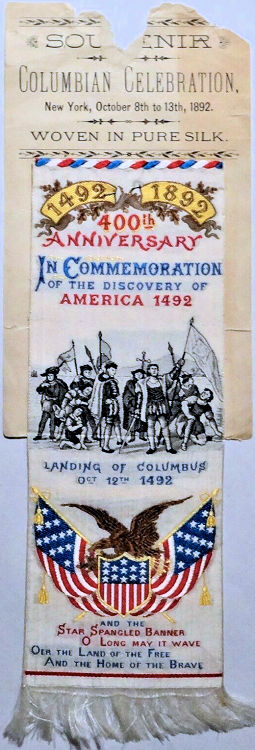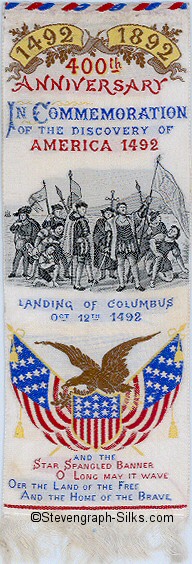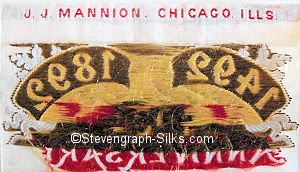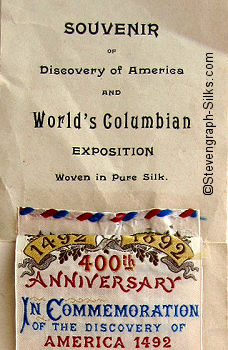There are three images recorded above.
Third image, with no backing paper:
This bookmark has "J J MANNION, CHICAGO, ILLS." woven on the reverse top turnover.
It is believed that Mannion was an agent of Stevens, although it is also possible they were weavers in their own right. It is attributed to Stevens only because it matches a silk bookmark within the Stevens' Family Album preserved at the Herbert Art Gallery and Museum, Coventry.
Whilst Stevens did not make many frayed end bookmarks, the style and quality of this bookmark is typical of Stevens.
As with the other images above, this bookmark would have originally been issued attached to a printed stiff supporting backing paper. The printing on this paper was universal to all these " 1492 - 1892 400th Anniversary " dated World's Columbian Exposition silks, although none had the Stevens name printed.
Also recorded in this Stevens bookmark catalogue are a series of " SOUVENIR " bookmarks, featuring the Worlds Columbian Exposition, Chicago, 1893. Over several years the membership of the Stevengraph Collectors Association looked at the stiff backing papers for these SOUVENIR bookmarks. From admittedly a small sample, the conclusion was nevertheless drawn that:
where the printing on the paper said " SOUVENIR WOVEN AT THE . . ", the attached bookmark had been woven by STEVENS.
where the printing on the paper said " SOUVENIR OF DISCOVERY . . ", the attached bookmark had probably been woven by J.J. MANNION.
An example of this can be seen in the record of the Stevens Souvenir bookmark - sb1884, where both printed stiff backing papers are displayed.
As can be seen from the images immediately above, this bookmark has the Mannion name woven on the reverse, and the stiff backing paper wording of " Souvenir of Discovery . ." is consistent with the Stevengraph Collectors Association analysis.
Until such time however that this silk can be positively identified to Stevens, it is recorded here as if it were of his manufacture.
Second, middle image, with New York backing paper:
These Columbus bookmarks are normally attributed to Stevens as they were assumed to have been produced at the Columbian Exposition, which opened on 1 May 1893, and at which Stevens is thought to have had a loom operational.
As can be seen from the printing on the stiff backing paper above, this silk was made in the October of the previous year - some 6 months earlier - and there is no evidence that Stevens attended that Columbian Celebration. Nevertheless, it is possible that Stevens bought over his loom to the USA at an earlier date, and that these bookmarks were woven in the States. It is also possible Stevens woven these in Coventry, and Mannion imported them, which he attached to the Columbian Celebration backing paper. Whilst not shown, it is confirmed that this bookmark has the MANNION name woven on the reverse top turn-over; as with the 1893 Exposition version. Nevertheless, we just do not know either who actually wove these silks, nor where.
I have been provided with the following information relating to this bookmark:
In July 1892 President Harrison declared a national holiday on October 21st 1892 to commemorate the 400th anniversary of the Discovery of America; this was a preliminary to the World Columbian Exposition in Chicago that opened its gates on May 1st 1893.
New York narrowly missed the opportunity to host the exposition, and the Mayor of New York, Hugh J. Grant, responded to Harrison's national holiday by declaring a 5 day celebration, and this became The Columbian Celebration. This bookmark was made for that celebration, with the dates of October 8th to 13th, 1892 printed on the stiff backing paper.
This explains why the bookmark is attached to a backing paper dated 6 months before the Columbian Exposition, but unfortunately still leaves open as to who actually made the silk bookmark, Stevens or Mannion, and also how they managed to produce it so early.
First image, with 1904 Louisiana Purchase backing paper:
The bookmark on the left has been added after the narrative above. The actual bookmark is identical to the 1892 / 1893 one, but as can be seen the stiff backing paper is of the LOUISIANA PURCHASE EXPOSITION, held in 1904. It is perhaps a testament that this bookmark design was still popular after 12 years. A detailed internet search of the participants at this Exposition failed to reveal the presence of either Stevens or Mannion, and again, there is no evidence that either had a loom working in America in 1904.





